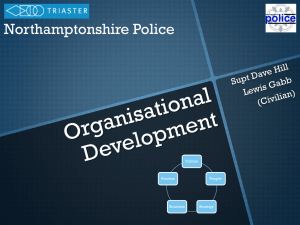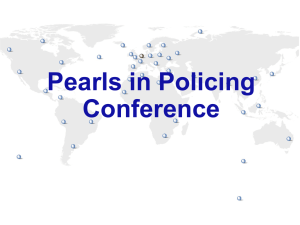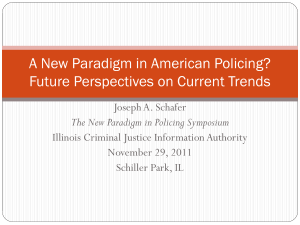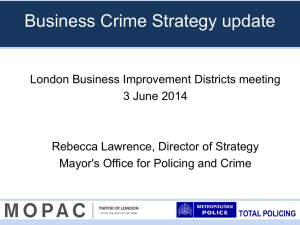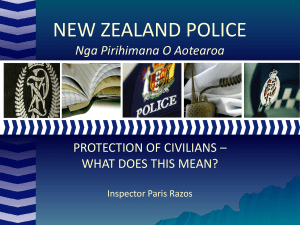Understanding Police Organizational transition to
advertisement
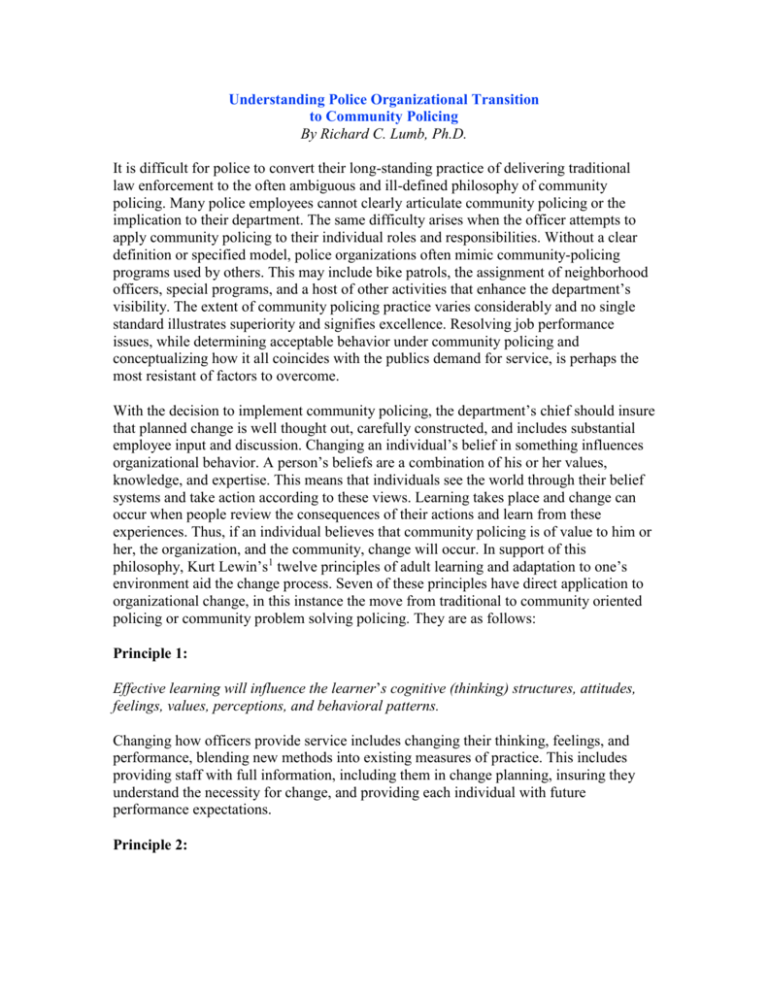
Understanding Police Organizational Transition to Community Policing By Richard C. Lumb, Ph.D. It is difficult for police to convert their long-standing practice of delivering traditional law enforcement to the often ambiguous and ill-defined philosophy of community policing. Many police employees cannot clearly articulate community policing or the implication to their department. The same difficulty arises when the officer attempts to apply community policing to their individual roles and responsibilities. Without a clear definition or specified model, police organizations often mimic community-policing programs used by others. This may include bike patrols, the assignment of neighborhood officers, special programs, and a host of other activities that enhance the department’s visibility. The extent of community policing practice varies considerably and no single standard illustrates superiority and signifies excellence. Resolving job performance issues, while determining acceptable behavior under community policing and conceptualizing how it all coincides with the publics demand for service, is perhaps the most resistant of factors to overcome. With the decision to implement community policing, the department’s chief should insure that planned change is well thought out, carefully constructed, and includes substantial employee input and discussion. Changing an individual’s belief in something influences organizational behavior. A person’s beliefs are a combination of his or her values, knowledge, and expertise. This means that individuals see the world through their belief systems and take action according to these views. Learning takes place and change can occur when people review the consequences of their actions and learn from these experiences. Thus, if an individual believes that community policing is of value to him or her, the organization, and the community, change will occur. In support of this philosophy, Kurt Lewin’s1 twelve principles of adult learning and adaptation to one’s environment aid the change process. Seven of these principles have direct application to organizational change, in this instance the move from traditional to community oriented policing or community problem solving policing. They are as follows: Principle 1: Effective learning will influence the learner’s cognitive (thinking) structures, attitudes, feelings, values, perceptions, and behavioral patterns. Changing how officers provide service includes changing their thinking, feelings, and performance, blending new methods into existing measures of practice. This includes providing staff with full information, including them in change planning, insuring they understand the necessity for change, and providing each individual with future performance expectations. Principle 2: People will believe more in knowledge they have discovered themselves than in knowledge presented by others. Assigning individuals the task of determining how other agencies function under a community-policing model, the effects of change on the organization, their successes and failures, etc., leads to a greater comfort level. After determining relevant facts, the individual applies this information to his or her agency and weighs out the benefits and drawbacks involved. Following this assessment, the individual will be able to judge the value of community policing to their respective agency. Hopefully it will be positive and relevant facts will be shared with others in the organization. Principle 3: Learning is more effective when it is an active rather than a passive process. When a person can determine the value of a practice, theory, or concept they understand it more thoroughly. Understanding relates to past knowledge and past learning, which when combined, the longevity of retention and application is extended. Another way of saying this is, until applied and used in one’s daily work, most concepts, practice, and theory is not completely understood. Determining ways in which staff can "use" and apply new ideas and practices stands a stronger chance of regular use, even becoming acculturated into the daily life of the individual. Training in community policing (COP) and community problem oriented policing (CPOP) must include real application and experience if we expect it to become habit. Principle 4: Acceptance of new ideas, attitudes, and behavioral patterns cannot be brought about by a piecemeal approach. Ones whole cognitive, affective, and behavioral system has to change. Interconnected, all three elements act as a whole rather than separate parts. When trying to bring about individual change, training and education must simultaneously address the learner’s feelings, behaviors, and thinking, as each is related to the other. Consistency, clarity of the message, and intent are woven together to provide the individual with all necessary information. This allows the person to rationalize their choice, find commonality and benefit from change, and the ability to determine how it will improve and support current modes of practice and service delivery. COP/CPOP dribbled out over a period of months never takes shape, leaving individuals to practice what they know best, which brings a false sense of comfort. With the decision to proceed, all aspects of change must be thoroughly planned and executed. Staff must have the benefit of complete knowledge and background before asking them to engage in personal and organizational change. Principle 5: It takes more than information to change ideas, attitudes and behavioral patterns. Merely telling staff that COP/CPOP will become the department’s way of conducting business assures failure. It goes beyond providing a rationale for change or providing reading material. The majority of employees will attempt to assimilate what change means to their job, evaluation, assignments and other components that impact on the delivery of police service. Examples of how COP/CPOP will reduce crime and allow officers to spend their time more wisely, points out the benefits and obstacles that will be encountered and resolved. Once provided with sufficient information to understand the new concept, officers should reflect, discuss, and report the benefits of making a change. Plans for accomplishing the adoption and practice of COP/CPOP must include a broad section of the department, as those who are engaged in the planning and decision-making become stakeholders, thus increasing the likelihood of success. Principle 6: Behavior changes will be temporary unless the ideas and attitudes underlying them are changed. Telling employees that the department has adopted either the COP or CPOP philosophy and that all personnel will begin to use these practices, has little to no effect when it applies to enthusiasm and long-term adoption of the concepts. It is necessary to change individual attitudes and ideas, instill practice with belief and encourage a willingness to participate and follow the new way of conducting business. Longevity depends on not only organizational commitment and support; it is also about each individual’s willingness to make the transition to conducting business and delivering services using the COP/CPOP model. Principle 7: Changes in perception of oneself and one’s social environment are necessary before changes in ideas, attitudes, and behavior will take place. Staff must believe they are capable of behavior that is appropriate to situations in which they find themselves. One’s self-perception serves as a guide to your personal beliefs and resulting behavior in the work environment. Traditional law enforcement is comfortable to the experienced officer and switching to a new program, something as ambiguous as COP/CPOP, often meets with resistance. Convincing officers of the benefits of COP/CPOP is a hard sell, but when successful, the rewards are outstanding. Summary Changing individual behavior and organizational tradition is a difficult and sometimes impossible task. With the decision to implement change, steps must be taken to ease the process and reduce the extent of employee anxiety. Employees should participate in change planning, contribute ideas and suggestions, and explore the implication of change on the tasks they perform as part of their job. The urgency to implement a new idea often overshadows taking sufficient time to include employees in the process. Today’s police officer is often torn between the old style of traditional law enforcement and the newer community-policing model. If employees were allowed to participate in the planning process and provide feedback from the beginning, implementation of community policing would be easier to achieve. Challenges in implementing COP lie ahead, but we will be better prepared to address them if we but pause for a moment and organize how we will address future change initiatives. To do less is to invite failure. Note: A future article will provide process steps to implement organizational change. 1. Johnson, D,. and Johnson F. (1991). Joining Together: Group Theory and Group Skills. rev. ed. Englewood Cliffs, N.J.: Prentice Hall, 1991.


